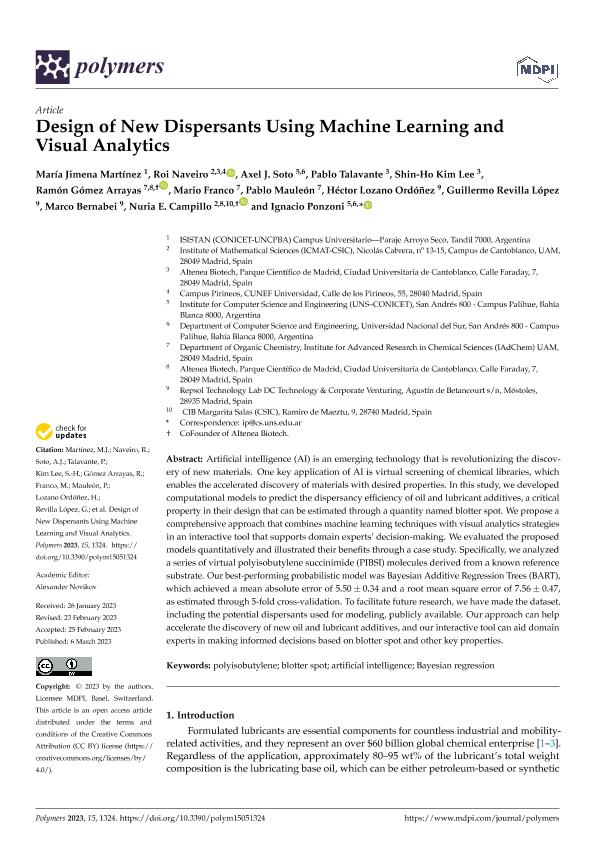Mostrar el registro sencillo del ítem
dc.contributor.author
Martínez, María Jimena

dc.contributor.author
Naveiro, Roi
dc.contributor.author
Soto, Axel Juan

dc.contributor.author
Talavante, Pablo
dc.contributor.author
Kim Lee, Shin Ho
dc.contributor.author
Gómez Arrayas, Ramón
dc.contributor.author
Franco, Mario
dc.contributor.author
Mauleón, Pablo
dc.contributor.author
Lozano Ordóñez, Héctor
dc.contributor.author
Revilla López, Guillermo
dc.contributor.author
Bernabei, Marco
dc.contributor.author
Campillo, Nuria E.
dc.contributor.author
Ponzoni, Ignacio

dc.date.available
2023-10-03T12:44:12Z
dc.date.issued
2023-03
dc.identifier.citation
Martínez, María Jimena; Naveiro, Roi; Soto, Axel Juan; Talavante, Pablo; Kim Lee, Shin Ho; et al.; Design of New Dispersants Using Machine Learning and Visual Analytics; MDPI; Polymers; 15; 5; 3-2023; 1-18
dc.identifier.issn
2073-4360
dc.identifier.uri
http://hdl.handle.net/11336/213889
dc.description.abstract
Artificial intelligence (AI) is an emerging technology that is revolutionizing the discovery of new materials. One key application of AI is virtual screening of chemical libraries, which enables the accelerated discovery of materials with desired properties. In this study, we developed computational models to predict the dispersancy efficiency of oil and lubricant additives, a critical property in their design that can be estimated through a quantity named blotter spot. We propose a comprehensive approach that combines machine learning techniques with visual analytics strategies in an interactive tool that supports domain experts’ decision-making. We evaluated the proposed models quantitatively and illustrated their benefits through a case study. Specifically, we analyzed a series of virtual polyisobutylene succinimide (PIBSI) molecules derived from a known reference substrate. Our best-performing probabilistic model was Bayesian Additive Regression Trees (BART), which achieved a mean absolute error of (Formula presented.) and a root mean square error of (Formula presented.), as estimated through 5-fold cross-validation. To facilitate future research, we have made the dataset, including the potential dispersants used for modeling, publicly available. Our approach can help accelerate the discovery of new oil and lubricant additives, and our interactive tool can aid domain experts in making informed decisions based on blotter spot and other key properties.
dc.format
application/pdf
dc.language.iso
eng
dc.publisher
MDPI
dc.rights
info:eu-repo/semantics/openAccess
dc.rights.uri
https://creativecommons.org/licenses/by/2.5/ar/
dc.subject
ARTIFICIAL INTELLIGENCE
dc.subject
BAYESIAN REGRESSION
dc.subject
BLOTTER SPOT
dc.subject
POLYISOBUTYLENE
dc.subject.classification
Ciencias de la Información y Bioinformática

dc.subject.classification
Ciencias de la Computación e Información

dc.subject.classification
CIENCIAS NATURALES Y EXACTAS

dc.title
Design of New Dispersants Using Machine Learning and Visual Analytics
dc.type
info:eu-repo/semantics/article
dc.type
info:ar-repo/semantics/artículo
dc.type
info:eu-repo/semantics/publishedVersion
dc.date.updated
2023-10-03T10:24:11Z
dc.journal.volume
15
dc.journal.number
5
dc.journal.pagination
1-18
dc.journal.pais
Suiza

dc.description.fil
Fil: Martínez, María Jimena. Consejo Nacional de Investigaciones Científicas y Técnicas. Centro Científico Tecnológico Conicet - Tandil. Instituto Superior de Ingeniería del Software. Universidad Nacional del Centro de la Provincia de Buenos Aires. Instituto Superior de Ingeniería del Software; Argentina
dc.description.fil
Fil: Naveiro, Roi. Instituto de Ciencias Matemáticas; España
dc.description.fil
Fil: Soto, Axel Juan. Consejo Nacional de Investigaciones Científicas y Técnicas. Centro Científico Tecnológico Conicet - Bahía Blanca. Instituto de Ciencias e Ingeniería de la Computación. Universidad Nacional del Sur. Departamento de Ciencias e Ingeniería de la Computación. Instituto de Ciencias e Ingeniería de la Computación; Argentina. Universidad Nacional del Sur. Departamento de Ciencias e Ingeniería de la Computación; Argentina
dc.description.fil
Fil: Talavante, Pablo. No especifíca;
dc.description.fil
Fil: Kim Lee, Shin Ho. No especifíca;
dc.description.fil
Fil: Gómez Arrayas, Ramón. Universidad Autónoma de Madrid; España
dc.description.fil
Fil: Franco, Mario. Universidad Autónoma de Madrid; España
dc.description.fil
Fil: Mauleón, Pablo. Universidad Autónoma de Madrid; España
dc.description.fil
Fil: Lozano Ordóñez, Héctor. No especifíca;
dc.description.fil
Fil: Revilla López, Guillermo. No especifíca;
dc.description.fil
Fil: Bernabei, Marco. No especifíca;
dc.description.fil
Fil: Campillo, Nuria E.. Instituto de Ciencias Matemáticas; España. Consejo Superior de Investigaciones Científicas. Centro de Investigaciones Biológicas; España
dc.description.fil
Fil: Ponzoni, Ignacio. Consejo Nacional de Investigaciones Científicas y Técnicas. Centro Científico Tecnológico Conicet - Bahía Blanca. Instituto de Ciencias e Ingeniería de la Computación. Universidad Nacional del Sur. Departamento de Ciencias e Ingeniería de la Computación. Instituto de Ciencias e Ingeniería de la Computación; Argentina
dc.journal.title
Polymers
dc.relation.alternativeid
info:eu-repo/semantics/altIdentifier/url/https://doi.org/10.3390/polym15051324
dc.relation.alternativeid
info:eu-repo/semantics/altIdentifier/doi/http://dx.doi.org/10.3390/polym15051324
Archivos asociados
